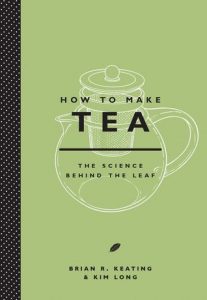 I thought this was a handsome little book, and was immediately drawn to it in Chapters when it released. Flipping through it, I thought the illustrations were unique, I thought the Table of Contents was very straightforward, and it seemed like it covered all of the basics while leaning away from that more ‘health benefit/herbal tea’ push. I was drawn in by the ‘Science Behind the Leaf’ aspect, and was looking forward to reading the ‘Tea Chemistry’ section.
I thought this was a handsome little book, and was immediately drawn to it in Chapters when it released. Flipping through it, I thought the illustrations were unique, I thought the Table of Contents was very straightforward, and it seemed like it covered all of the basics while leaning away from that more ‘health benefit/herbal tea’ push. I was drawn in by the ‘Science Behind the Leaf’ aspect, and was looking forward to reading the ‘Tea Chemistry’ section.
I had high hopes for it, but as usual, it went onto my “To Read Tea Shelf” behind all of my other acquisitions for a few years.
Spoilers: I ended up hating the book.
Maybe “hate” is a strong word, but I think there are several MUCH better written guides on the market already, with less points against them than this one.
To start, the book could have used several more proof-reads and spellchecks, especially from people working in the tea industry. “Green Couch Spring” tea was so funny, I had to post it to Instagram. Oddities like “Eastern Beauty” coming from China, Sowmee (Shoumei) “green” tea (described as ‘small twisted leaves, similar to black broken grades’. I spent a good hour puzzling over this, trying to find an alternative green tea that might have flown under the name ‘sowmee’, but all my results just brought me back to shoumei white).
Edit: mbanu on teaforums.org posted their research into antique tea names, leading me to Chow and Kramer’s All the Tea in China, which gives sowmee as xiumei, separate from ‘showmei’ as ‘shoumei’. It does, however, list both of these as green teas. I could find sparingly little on xiumei.
This leads into another issue–oddly outdated historical views. This is a modern publication, but it chooses to use some confusingly outdated or pre-pinyin spellings for many teas. It still describes pu-erh as “mysterious” and “strange”. “Tea experts rarely concur on how exactly pu-erh is processed”… I feel this book was published too late in an era were touring teafarms is common.
It also dances confusingly around descriptions of the Opium War, and I had to reread several passages because I was (and still am) unsure on whether they were blaming the Opium War on China itself, or Robert Fortune (who’s famous tale occurred after the war).
The pictures that I thought were charming at first, I realized add absolutely nothing to the book. Most of the artistic renditions of different teas look the exact same–like little circles of scribbles. They add no benefit, nor do the crisp diagram of what a water filter pitcher looks like, or a circular Tetley-style teabag. That seems like an overly harsh thing to criticize, but the further I read, the more I found myself asking “why did this need a picture”.
I picked this up because I was drawn in by the ‘Science’ in the title, and the opening of the chapter on Tea Chemistry cautions against believing all tea health facts–and then immediately afterwards touts tea as a ‘panacea’, and goes on to spout health claims (“studies show”) for the entire chapter, without sources.
The sources! The citing is all over the place. It has a bibliography, but also uses foot notes to cite. Or a superscript. Sometimes it just says “see bibliography” without so much as a paper name or author to look up. Sometimes it just says “some experts” or “some studies”. If it bothers to state a source at all. It almost never lists sources for claims that require something, but will cite a source for something completely innocuous (they cited a source on their claim on there being 5,600 scientific studies on tea… Yes).
Section Six, How To Make Tea, could have been the saving grace. It’s written concisely and is easy to follow, although some of the accompanying diagrams are confusing. It’s simple, no-fuss, and offers brief examples of how to go about it in several cultures (including gongfu with a teapot or a gaiwan, western with a strainer, and Indian chai). The corresponding diagrams for this section were a little confusing.
In an effort to keep my reviews a little more concise, I’ll say that it’s a handsome volume, the simplicity and binding of the cover stood out on the bookshelf. It’s weaved, feels nice, but didn’t hold up well being tucked into my backpack. But as far as ‘guides’ go for tea, there are much better volumes on the market. Many that spend time breaking down individual teas (which this one does not), and include in-depth brewing guides.
I ended up reading The Philosophy of Tea by Tony Gebely right after this one, a similar idea, but another post.




Leave a Reply
You must be logged in to post a comment.